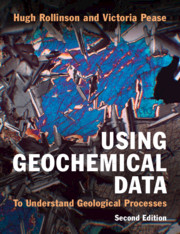Book contents
- Using Geochemical Data
- Reviews
- Using Geochemical Data
- Copyright page
- Contents
- Preface to the Second Edition
- Preface to the First Edition
- Abbreviations
- 1 Geochemical Data
- 2 Analysing Geochemical Data
- 3 Using Major Element Data
- 4 Using Trace Element Data
- 5 Using Geochemical Data to Identify Tectonic Environments
- 6 Using Radiogenic Isotope Data
- 7 Using Stable Isotope Data
- Appendices
- References
- Index
7 - Using Stable Isotope Data
Published online by Cambridge University Press: 15 April 2021
- Using Geochemical Data
- Reviews
- Using Geochemical Data
- Copyright page
- Contents
- Preface to the Second Edition
- Preface to the First Edition
- Abbreviations
- 1 Geochemical Data
- 2 Analysing Geochemical Data
- 3 Using Major Element Data
- 4 Using Trace Element Data
- 5 Using Geochemical Data to Identify Tectonic Environments
- 6 Using Radiogenic Isotope Data
- 7 Using Stable Isotope Data
- Appendices
- References
- Index
Summary
The geochemical applications of the traditional stable isotopes H, O, C, S and N and the non-traditional stable isotopes Li, Mg, Si, Cr and Fe are presented in this chapter. The standard isotopic notation, reference standards and isotopic distributions in some planetary reservoirs and the major Earth reservoirs are given for each isotope system. In each case the processes of equilibrium and kinetic fractionation are discussed and applied to high- and low-temperature (Earth surface and biological) systems and the fractionation factors listed. The utility of each isotope system as a tracer in geological and biological processes is discussed with applications to planetary differentiation, high-temperature igneous processes and low-temperature processes at the Earth’s surface in the terrestrial and aqueous environment and in living organisms. Stable isotopes are shown to be an important tracer for the evolution of life on Earth and the development of the Earth’s atmosphere.
Keywords
- Type
- Chapter
- Information
- Using Geochemical DataTo Understand Geological Processes, pp. 219 - 285Publisher: Cambridge University PressPrint publication year: 2021
- 2
- Cited by

